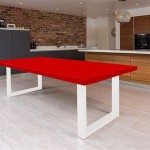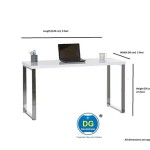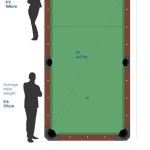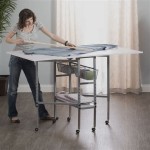Do It Yourself Bar Height Table: A Comprehensive Guide
The creation of a bar height table through a do-it-yourself (DIY) approach offers a cost-effective and customizable solution for enhancing a variety of spaces, from kitchens and dining areas to home bars and patios. Constructing a bar height table enables individuals to tailor the dimensions, style, and materials to perfectly complement their specific needs and aesthetic preferences. This article provides a comprehensive guide to the process, outlining essential considerations, materials, tools, and step-by-step instructions for successfully completing such a project.
Before embarking on the construction process, a thorough evaluation of the intended use and location of the table is crucial. This assessment will inform decisions regarding size, shape, and material selection. A bar height table typically measures between 40 and 42 inches in height, requiring taller chairs or stools. Consider the amount of seating required and the available space to determine the optimal dimensions of the tabletop. A smaller, round table may be suitable for a compact area, while a larger, rectangular table accommodates more people and works well in larger rooms or outdoor spaces.
Material selection is a fundamental aspect of the project. The choice of wood, metal, or a combination thereof will significantly impact the table's appearance, durability, and overall cost. Hardwoods such as maple, oak, and walnut offer excellent strength and aesthetic appeal but are generally more expensive than softwoods like pine. Reclaimed wood presents a sustainable and characterful option, adding a unique, rustic touch. Metal frames provide a modern and industrial aesthetic, known for their stability and longevity. The tabletop material should be selected based on its durability, resistance to stains and scratches, and compatibility with the overall design.
The construction process demands the availability of appropriate tools and safety equipment. Essential tools include a measuring tape, saw (circular saw, miter saw, or hand saw), drill, screwdriver, sander, clamps, and a level. Safety glasses, gloves, and a dust mask are necessary for protecting oneself from potential hazards. Adequate ventilation is also crucial, particularly when working with finishes and adhesives.
Planning and Design Considerations
Prior to the commencement of any physical construction, a detailed plan is essential. This plan should include precise measurements of all components, a visual representation of the table (a sketch or digital rendering), and a comprehensive list of materials. The plan serves as a guide throughout the project, minimizing errors and ensuring that the final product aligns with the intended design. Consider the desired style of the table – modern, rustic, minimalist, or traditional. This stylistic direction will inform the choice of materials, finishes, and decorative elements.
Accurate measurements are paramount. Carefully measure the desired height, width, and depth of the table. Account for the thickness of the tabletop and the legs. When designing the base, consider the placement and angle of the legs to ensure stability and prevent wobbling. A wider base generally provides greater stability, especially for larger tabletops. Create a cut list based on the measurements, outlining the precise dimensions of each piece of lumber or metal required. This list will streamline the cutting process and minimize material waste.
The design should also address the method of joining the various components. Common joinery techniques include screws, nails, dowels, and mortise-and-tenon joints. Screws and nails are the simplest to use, but dowels and mortise-and-tenon joints provide greater strength and durability. The chosen joinery method should be appropriate for the materials being used and the overall structural requirements of the table. For example, metal frames can be welded together for maximum strength, while wooden components can be joined using a combination of screws, glue, and dowels.
Construction of the Table Base
The table base forms the structural foundation of the entire table. Whether constructed from wood or metal, the base must be sturdy enough to support the weight of the tabletop and any items placed upon it. A well-designed base should also distribute the weight evenly to prevent instability and potential tipping.
For a wooden base, begin by cutting the lumber according to the cut list. Sand all pieces to remove any rough edges or splinters. Assemble the legs first, ensuring that they are square and plumb. Use clamps to hold the legs in place while attaching them to the frame with screws and glue. For added strength, consider using dowels or mortise-and-tenon joints. If desired, add a stretcher bar between the legs for increased stability. The stretcher bar should be positioned a few inches above the floor and securely attached to the legs. Ensure that all joints are tight and that the base is level before proceeding to the next step.
For a metal base, the process involves cutting and welding the metal components together. Safety precautions are paramount when working with welding equipment. Wear appropriate protective gear, including a welding helmet, gloves, and a fire-resistant apron. Use a metal cutting saw or grinder to cut the metal to the required dimensions. Clean the edges of the metal before welding to ensure a strong and clean weld. Assemble the legs and frame by welding them together, paying close attention to the alignment and squareness of the joints. Grind down any rough welds to create a smooth and even surface. Apply a coat of primer and paint to protect the metal from rust and corrosion.
Regardless of whether the base is constructed from wood or metal, it is essential to ensure that it is stable and level before attaching the tabletop. Use a level to check the legs and adjust them as needed. If the base is uneven, add shims under the legs to level it. A wobbly base can compromise the stability of the entire table and make it unsafe to use.
Creating and Attaching the Tabletop
The tabletop is the focal point of the bar height table and should be chosen to complement the base and the overall aesthetic of the space. The tabletop can be constructed from a single piece of wood, multiple pieces of wood joined together, or a different material such as concrete, stone, or metal.
If using a single piece of wood, select a board that is free from knots, cracks, or other imperfections. Sand the surface smooth and apply a finish of your choice. For a rustic look, consider using reclaimed wood with its natural imperfections and character. If joining multiple pieces of wood, use a jointer and planer to create perfectly flat and square edges. Apply wood glue to the edges and clamp the pieces together until the glue has dried. Consider using biscuits or dowels to reinforce the joints. Sand the tabletop smooth and apply a finish.
When attaching the tabletop to the base, several methods can be employed. Screws are a common and straightforward option. Position the tabletop on the base and drill pilot holes through the frame and into the underside of the tabletop. Use screws that are long enough to penetrate the tabletop securely but not long enough to go through the top. Alternatively, consider using metal brackets or corner braces to attach the tabletop to the base. These brackets provide a strong and secure connection and can be easily concealed. For wooden bases, wood glue can also be used in conjunction with screws or brackets to create a more durable bond.
After attaching the tabletop, inspect the entire table for any imperfections or loose joints. Tighten any screws or bolts as needed. Apply a final coat of finish to the tabletop to protect it from scratches, stains, and water damage. Consider using a polyurethane finish for its durability and water resistance. Allow the finish to dry completely before using the table. The final step involves adding any decorative elements, such as edge banding, decorative trim, or metal accents. These details can enhance the aesthetic appeal of the table and personalize it to your specific taste.
By following these detailed instructions and paying close attention to each step, it is possible to create a high-quality, custom-designed bar height table that will enhance any space. The project requires careful planning, attention to detail, and the use of appropriate tools and materials. The result is a functional and aesthetically pleasing piece of furniture that reflects individual craftsmanship and ingenuity.

How To Build A 2x4 Outdoor Bar Table The Diy Dreamer

Build This Pub Style Table For Around 70 Step By Instructions Diy Home Ideas Furniture Decor

Bar Height Table Reclaimed Wood Other Sizes Available 550 00 Via Pub And Chairs Diy Pallet Furniture

Do It Yourself Home Bar Posted By Spencer Horn Kitchen Table Diy Height Dining

Barn Xo High Top Bar Table Height 42 With Powder Coated Brooklyn Leg Base Choose From Size And Finish

Diy Kitchen Bar Table And Chair Build Plans Dining Set Furniture Easy To File Instant Denmark

Rustic Diy Pub Table Landscape Blocks For Legs And Wood From Old Grainery Tabletop Outdoor Tables Chairs

Reclaimed Factory Maple Waterfall Bar Wood Dining Table Diy Kitchen Island Height

Lofka Bar Table Set For 4 Pub Dining Room Kitchen Home With Stools 250lbs Black Com
:max_bytes(150000):strip_icc()/charlestoncrafted-b52d47713ae44d57a8f06697b427b9fe.jpg?strip=all)
18 Diy Outdoor Table Plans








